Since its development in 1964 by John Moore [1], size-exclusion chromatography (SEC, also known as gel permeation chromatography or GPC) has become a premier method for characterizing the molar mass averages, distributions, and physicochemical properties of both natural and synthetic polymers [2]. The power of SEC was realized almost immediately after its introduction, leading to widespread use of, and interest in, the technique. Meetings of practitioners and interested parties soon followed, with the first Gel Permeation Chromatography Symposium, sponsored by Waters Corp., taking place in Cleveland, OH in 1965 (see Figure). Being the only conference of its time dedicated to polymer chromatography (which, at the time, was essentially equivalent to SEC), this Symposium became an on-again, off-again mainstay over the next four decades, with the occasional multi-year hiatus as dictated by the global economy and the purchasing powers-that-be. Its penultimate revival, which lasted through the 1990s, ended its run in 2003 in Baltimore, as a joint meeting with the International Symposium on Polymer Analysis and Characterization.
Figure 1.

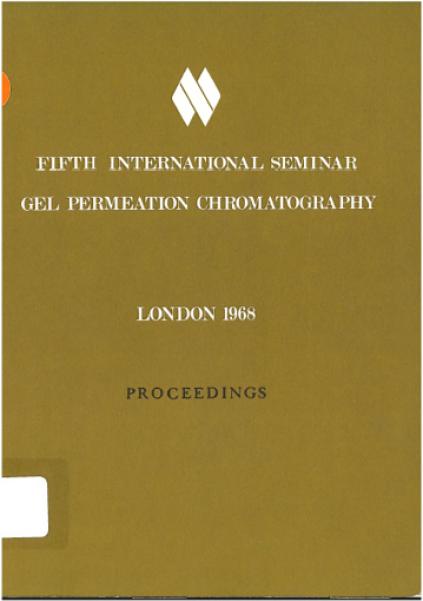
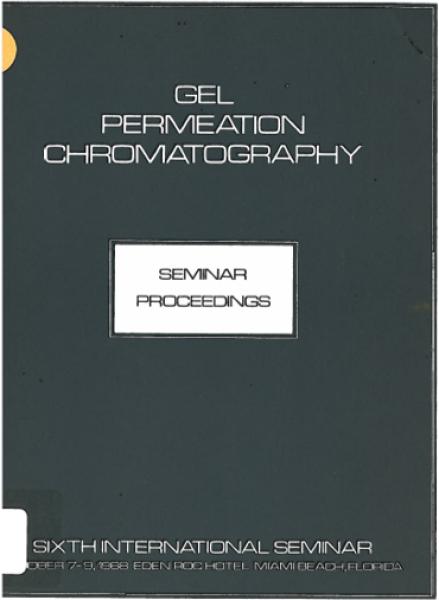
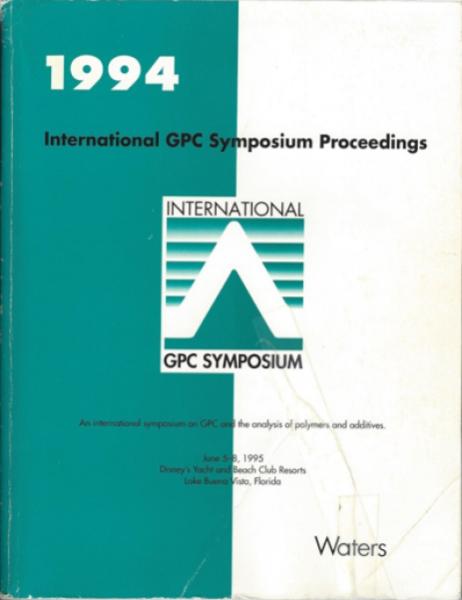
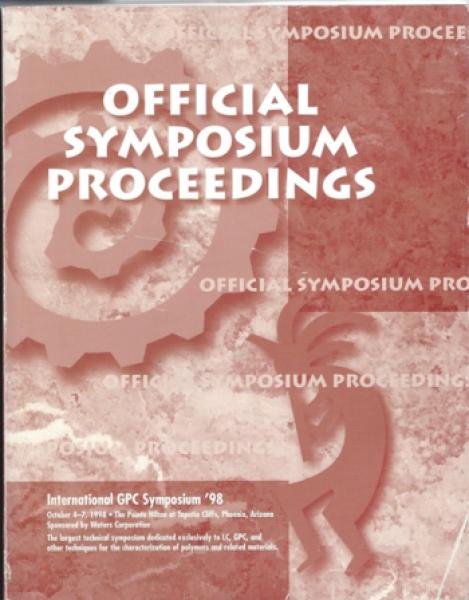
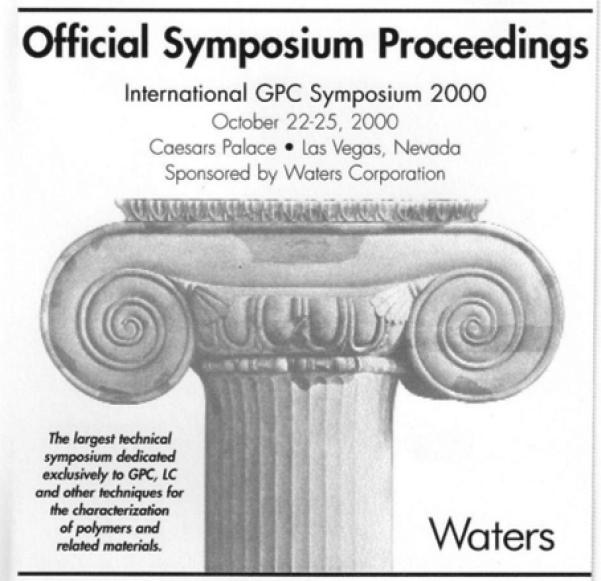
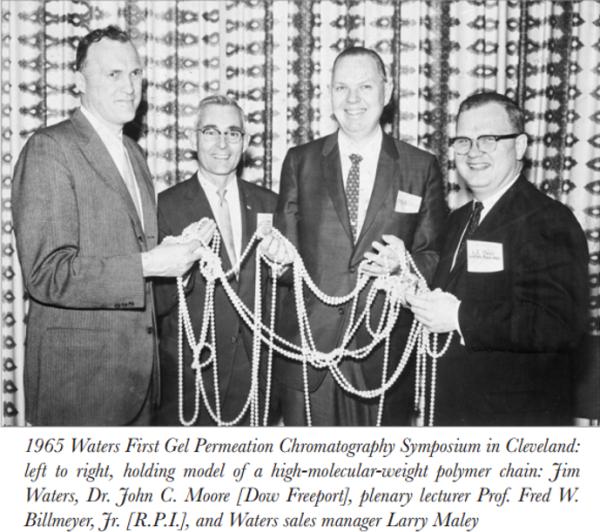
Covers of proceedings books from previous International GPC Symposia. Top row: Miami Beach, 1967 (left), London, 1968 (right); second row: Miami Beach, 1968 (left), Lake Buena Vista, Florida, 1994 (right); third row: Phoenix, Arizona, 1998 (left), Las Vegas, 2000 (right). Bottom: Photo taken at the first Waters International GPC Symposium, Cleveland, Ohio, 1965. In photo, from left to right, holding a model of a high molar mass polymer: Jim Waters, John C. Moore (Dow Freeport), plenary lecturer Fred W. Billmeyer, Jr. (Rensselaer Polytechnic Institute), and Waters sales manager Larry Maley. (Photo courtesy of Waters Corp.; proceedings covers from author's collection).
The Symposium was revived two years ago, under the joint auspices of Waters and PSS Polymer Standards Service. The 2014 Symposium took place in Frankfurt, Germany. The meeting is now renamed the International Symposium on GPC/SEC and Related Techniques, to reflect the fact that macromolecular separation science has extended beyond the reach of SEC. With the desire to alternate annually between the United States and Europe, the 2105 Symposium took place in Philadelphia, PA between October 20 and 22. The format followed one developed for last year's meeting, somewhat different from that of other conferences. The Symposium began with a Meet the Experts day, in which seven acknowledged experts (well, six and this editor) were given the opportunity to speak about topics of their choosing, with ample time for questions and discussion following each talk. The talks covered both one- and two-dimensional separations and both size-exclusion and interactive chromatography as well as field-flow fractionation.
Days 2 and 3 were divided into various sessions, each chaired either by one of the aforementioned Experts or by one of the Symposium organizers. Session topics included the potential and limitations of SEC; the application of MS, NMR, and IR to SEC; the use of viscometry and light scattering detection; talks on hyphenated fractionation and multidimensional techniques; non-SEC fractionation techniques (hydrodynamic chromatography, field-flow fractionation, temperature gradient interaction chromatography, etc.); and the use of computer modeling and simulations in interaction polymer chromatography. An addition to last year's conference was the inclusion of a small poster session (which, one hopes, will continue to grow with future Symposia), as well as a session highlighting vendors’ perspectives on current analytical challenges. Each session was comprised of three talks (four in the case of the vendors’ perspectives session), with discussion and questions postponed until after all the talks in a particular session were completed. After completion of the talks, all the speakers in each session were brought to the front of the room to field questions for approximately thirty minutes, either in the order in which the talks were presented or randomly, as decided by the session chair. This format certainly seems to allow for more discussion of any given individual topic than providing each speaker with a mere five minutes or so at the end of her or his talk.
Another innovative aspect of the revived Symposium is the Wisdom of the Crowd session. In this one-and-a-half hour session, the experts took a seat at the front of the room and discussed any of a number of issues, some being questions submitted by the attendees at the time of registration or during the conference, others being questions or concerns voiced during the session. In 2014, the Wisdom of the Crowd was expertly moderated by Scott Hanton from Intertek, who reprised his role with equal skill and panache at this past Symposium. Topics discussed included the characterization of crosslinked polymers, the study of polymer degradation during chromatographic analysis, the characterization of oligomers, novel and/or desired detection methods, and the need for polysaccharide and related standards, inter alia. Put in a better timeslot than it was last year, this was one of the most popular sessions.
The organizers have been wise to keep some of the features which made the old GPC Symposia a favorite amongst repeat attendees: No simultaneous sessions means that everyone is able to attend all the talks, without having to choose between two or more desirable talks which have been scheduled for the same timeslot. Most importantly (to this editor, at least), ample break time has been given for coffee and discussions, with these occurring amidst a small vendor exhibit. Given these breaks and the meals included with the conference registration, it was virtually impossible to not make contact with anyone desired. My own Rolodex has increased in size by a couple dozen business cards as a result.
The review and original papers included in this topical collection reflect some of the presentations given at the Symposium. As such, we see articles dealing with the characterization of polyethylene by multi-detector SEC employing a novel solvent, on the use of UPLC-MS and related methods for copolymer analysis, on the determination of oligomer molar mass distributions by SFC with evaporative mass detection, and on the versatility of viscometric detection in SEC and related techniques.
The next Symposium is scheduled for September 26 – 29, 2016 and will take place in Amsterdam, with a few changes. A pre-symposium education workshop has been added, along with two plenary lectures and new Experts. The willingness of the organizers to modify the agenda in response to attendee surveys and voiced opinions is yet another reason to add the International Symposium on GPC/SEC and Related Techniques to one's meeting calendar.
Footnotes
Disclaimer, and Complaince with Ethical Standards
Commercial products are identified to specify adequately the experimental procedure. Such identification does not imply endorsement or recommendation by the National Institute of Standards and Technology, nor does it imply that the materials identified are necessarily the best available for the purpose.
The author has no potential conflicts of interest to declare. The research presented here did not involve human participants and/or animals.
References
- 1.Moore JC. Gel permeation chromatography. I. A new method for molecular weight distribution of high polymers. J Polym Sci A. 1964;2:835–843. [Google Scholar]
- 2.Striegel AM, Yau WW, Kirkland JJ, Bly DD. Modern size-exclusion liquid chromatography. 2nd ed. Wiley; Hoboken, NJ: 2009. [Google Scholar]


